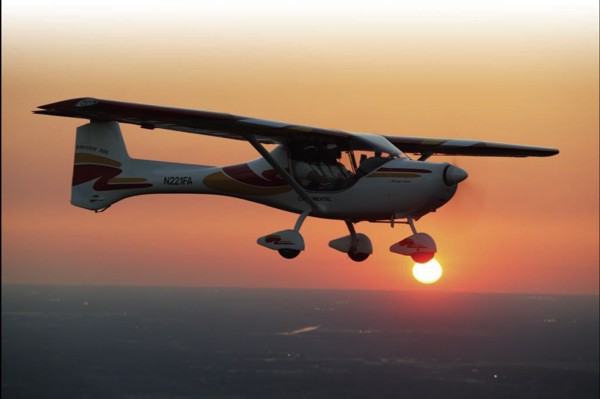
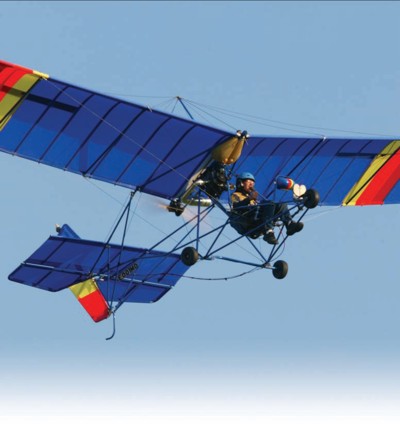
One year ago,
aviation experienced
a tectonic
plate change.
On the exact
day that Neil
Armstrong first
set foot on the
moon 35 years
earlier, the
Federal Aviation
Administration
(FAA) released
a new regulation-
known as
the sport pilot/
light-sport aircraft
rule, or its
abbreviation, SP/
LSA-that represents
the biggest
change in aviation
in 50 years.

If you’ve been fascinated
with flying or
seek a new adventure,
the sport pilot
certificate and new
light-sport aircraft
may be your ticket
to a glorious form of
three-dimensional
freedom.
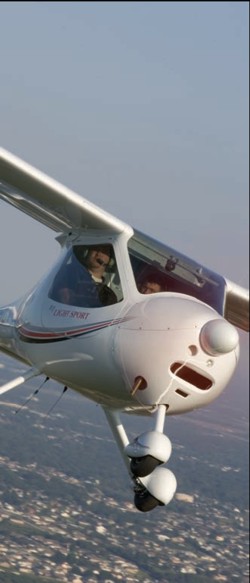

For More Information

What Sport Pilots Can Fly
Sport pilots can fly six categories of aircraft as shown here. Included in this graphic is the minimum number of training
hours required to earn a sport pilot certificate in that category. Note: Your instructor may suggest more training, if needed,
before recommending you to take your sport pilot tests.
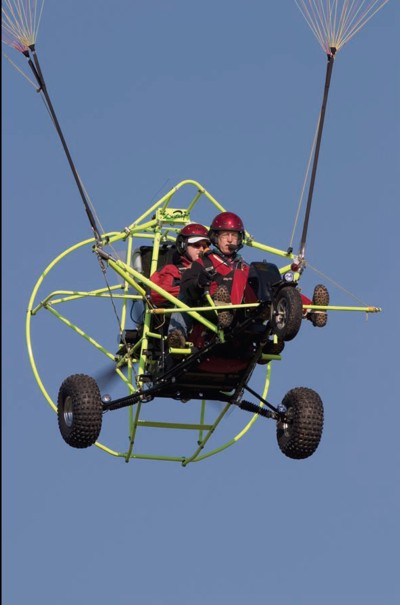
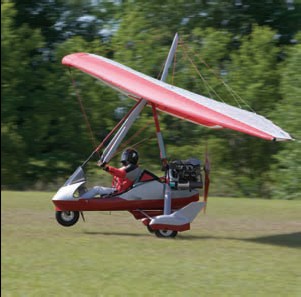
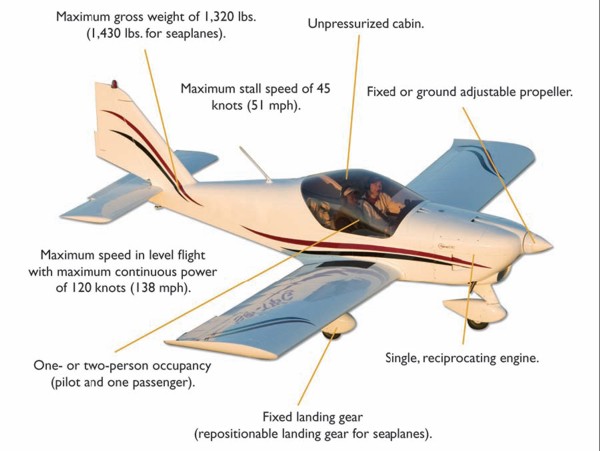
What Defines a Light-Sport Aircraft?
The FAA has defined a light-sport aircraft as any easy-to-fly aircraft that, since its initial certification, has continued
to meet the following performance parameters.
Sport pilot and light-sport aircraft,
what’s it all about?
If you’ve ever thought about
learning to fly, returning to
flying, or resuming flying lessons
that you started years ago,
congratulations; your timing is
just about perfect! This rule provides
new opportunities for you as well as
anyone who has dreamed of owning
an aircraft.
This article will summarize how
SP/LSA affects you. We’ll keep it simple;
when you’re ready for more,
EAA offers many ways to become
more informed (see “For More
Information”). Like many activities,
flying has its own language with
abbreviations, acronyms, forms, and
numbers to make discussing it faster.
Veteran pilots throw this lingo around
casually and often baffle those who
aren’t involved. We’ll avoid such jargon
in this article, and we’ll only use
abbreviations after we’ve explained
them.
Let’s Get Started!
SP/LSA has two basic components:
“Sport pilot” refers to a new pilot
certificate you can earn (the FAA calls
them certificates as opposed to licenses);
“Light-sport aircraft (LSA)” refers
to a new category of aircraft. Any
certificated pilot can fly an LSA, but
sport pilots can only fly aircraft that
meet the definition of an LSA. (See
“What Is a Light-Sport Aircraft?”)
We’ll talk about these two pieces
of the SP/LSA pie separately even
though they are deeply intertwined.
We will also give you the “tip of the
iceberg” view, as drilling down for
the other 90 percent takes time and
gets into aviation phrases that may
not be readily understandable. Again,
that’s where EAA’s resources can assist
you. (See “For More Information.”)
The SP/LSA regulation is wide
ranging. You may encounter current
pilots and even FAA personnel who
don’t understand it well or perhaps
misunderstand some of the details.
Other FAA regulations have numbers
like Part 91, Part 61, and Part
103 but not SP/LSA. It alters many
existing regulations, and in so doing,
SP/LSA has thrown a curve to many
experienced aviators who thought
they “knew the rules.” New pilots, however, don’t have to unlearn and
relearn. Therefore, new or returning
pilots may get up to speed quicker
than some experts, and that’s a nice
aspect of SP/LSA.
The Sport Pilot Certificate
Earning a sport pilot certificate
is akin to taking driver’s education.
You learn some basic information
and the “rules of the road,” practice
some skills with an instructor for a
defined number of hours, and get
approved to fly by yourself for a few
more hours|that’s called solo flying.
Then, when your instructor feels you
are competent, you make final preparations
to take two tests: a knowledge
test, which the FAA administers via
computer by two national testing
agencies, and a practical test, which
involves flying with an examiner and
demonstrating the skills required of
sport pilots as well answering some
questions the examiner will ask in
a verbal exam. Most pilots refer to
these as the written, oral, and flight
tests.
One of the benefits of the sport
pilot regulation is that it doesn’t require you to learn lots of difficult
tasks you won’t encounter in
your typical flying. Your training to
become a sport pilot will involve
learning the basic skills and safety
practices needed to fly for fun in
pleasant weather. You’ll fly in the
daytime with only one other occupant
at slower speeds, commonly
thought to be safer. You’ll learn to fly
a simple airplane in simple airspace.
More training is logically required of
a private pilot who’s allowed to fly an
aircraft with an unrestricted number
of occupants at higher speeds into
areas of higher air traffic congestion
in varying weather conditions.
Once you have your sport pilot
certificate, you can add additional
skills that will earn you more flying
privileges. To gain these added skills
you’ll need to spend a few more hours
training with an instructor. When
your instructor is confident you’ve
attained the required skill level, he
or she will sign your logbook-the
book where all your flight lessons
and flight time is recorded-signifying
you have earned this privilege.
You do not have to take any further
tests. That’s a big difference between
the sport pilot certificate and other
pilot certificates.
For example, let’s say you learned
to fly at a small private airstrip that
didn’t require radio communications.
Then, after you became more
confident in your flying skills, you
decided you want to venture to airports
that do require radio communication.
To add that privilege, you
would spend some time flying with
your instructor to gain the necessary
radio skills. When your instructor is
satisfied you’ve mastered that skill,
he or she will simply endorse your
logbook noting that you now have
that privilege.
You can also earn the privilege
to fly a different type of aircraft
than the one in which you originally
trained|for example, a powered
parachute instead of a fixedwing
airplane. The process to add a
new aircraft type to your sport pilot
privileges is also simple: fly with an instructor to gain the skills for this
new category of aircraft, and then
take a proficiency flight with a different
instructor. No further knowledge
or practical test is required.
There’s a wide variety of LSA available
to choose from. The diversity in
LSA is breathtaking and offers new
experiences for almost any aviator.
Lower Cost for Beginners
One of the best features of SP/LSA
is that it can dramatically lower the
cost to learn to fly. Most estimates for
earning a private pilot certificate suggest
the cost can run between $5,000
to $7,000 or more. For sport pilots,
the cost can range from $1,500 to
$2,500 or more, depending on the
category of aircraft in which you
learn to fly and where you live.
For example, if you learn to fly in
powered parachutes, which require
a minimum of 12 hours of training,
the cost could be less than $1,000 for
apt students.
You may continue training with an
appropriate instructor adding additional
skills and privileges, as you
desire. The experiences you accumulate
using your sport pilot certificate
can be applied toward other aviation
certificates you may wish to pursue,
such as a private pilot certificate or
an airline transport pilot rating, the
certificate required to fly an airliner.
You may even want to become a
sport pilot instructor and teach others
the skills you’ve acquired.
Medical Fitness
In the United States, once you
earn a pilot certificate, it has no
expiration date. However, for all pilot
certificates other than sport pilot, you
must also possess a valid medical
certificate verifying your medical fitness
to fly. Various classes of “medicals”
exist, depending on the level
of flying you want to do. The most
basic medical, a third-class medical,
requires that a pilot undergo a medical
examination a minimum of once
every two years. If you cannot pass
this medical exam, your pilot certificate
is no longer current.
The sport pilot certificate does not
have this requirement. If you possess
a valid U.S. driver’s license, you may
use this license as evidence of your
medical fitness. However, before every
flight, all pilots are required to selfcertify,
meaning that you don’t fly
when you’re not feeling up to it|that
is, have some malady that’s affecting
you or for which you’re taking medication
that recommends not driving
or operating heavy equipment.
Returning pilots who have allowed
their medical to expire can simply
choose to use their valid driver’s
license as their statement of medical
eligibility if they wish to fly as sport
pilots. However, pilots whose medical
has been denied, revoked, or suspended
must first clear their FAA
record before using their
driver’s license as their
medical.
It’s important to
note that any violation
or health situation
that suspends
your driving privileges
likewise suspends your
flying privileges; in
other words, if your driver’s
license is not currently
valid, you may not use that as
your evidence of medical fitness.
Light-Sport Aircraft-the Machines
In recent years, new aircraft have
become expensive to buy. However,
the establishment of the new LSA
category has dramatically dropped
the price of owning and operating
a new, ready-to-fly aircraft. At the
same time, aircraft designs have
become more modern and efficient.
Prior to SP/LSA, the cost of a new
fixed-wing airplane, for example,
was in excess of $170,000; now,
new fixed-wing LSA are available
from about $40,000 on, with the
average falling in the $60,000 to
$80,000 range.
This cost reduction resulted, primarily,
from a change in the standards
for the construction of readyto-
fly aircraft. With the adoption of
the SP/LSA rule, the FAA accepted
industry-developed consensus standards
in lieu of governmental standards
(known as FAR Part 23), which
added extra cost to the production
of aircraft.
While many pilots may think
about fixed-wing airplanes first,
weight-shift-control aircraft (trikes)
and powered parachutes may be the
most cost effective for sport pilots to
fly, commonly selling for $15,000 to
$50,000. These are simple, open-air
machines that fly between 30 mph
and 80 mph. You take lessons for
12-20 hours and then can carry a
passenger in an aircraft that has met
standards approved by the FAA. If
you’re looking for a different flying
experience, some gliders (sailplanes),
lighter-than-air aircraft (airships and
balloons), and gyrocopters also qualify
as LSA. (See “What Sport Pilots
Can Fly.”)
Other Aircraft Sport Pilots Can Fly
Sport pilots can also build and fly
kit planes. An entire fleet of aircraft
is for sale as “51 percent kits,” meaning
the owner must build more than
half of the aircraft. These aircraft are
called experimental amateur-built
or “homebuilt” aircraft. They must
be checked and given an airworthiness
certificate by an FAA-designated inspector before being flown. If such
an amateur-built aircraft meets the
definition of an LSA, then a sport
pilot may fly it. Many used aircraft
of this type make good purchases,
too, though it’s wise to seek plenty
of expert advice before buying such
an aircraft. Contact EAA’s Aviation
Services staff for advice; call 888/
EAA-INFO or e-mail info@eaa.org.
The SP/LSA rule also established a
new category of experimental lightsport
aircraft or E-LSA. The manufacturer
of these kits may complete
up to nearly 99 percent of the work
of building the aircraft, with the
owner finishing the rest. Before selling
such kits, however, the manufacturer
must first build one aircraft
to completion and show compliance
with the consensus standards governing
the construction of LSA.
Building a kit can be a satisfying
and educational experience, and it
can save an owner thousands of dollars.
Again, EAA has an entire support
network through its Aviation Services
staff to help those who want to build
an LSA airplane kit.
A number of previously manufactured
ready-to-fly airplanes like J-3
Cubs, Aeronca Champs, Luscombes,
and Ercoupes also meet the definition
of LSA and thus can be flown by
sport pilots.
Experimental aircraft kits and
ready-to-fly older aircraft cover a wide
swath of airplane types-from tailwheel
aircraft (taildraggers) to nosewheel
aircraft (tricycle gear) to World
War I and II reproductions to sleek
new all-metal or composite aircraft-
at a wide range of cost, offering sport
pilots even more inexpensive aircraft
choices.
LSA have definitely made owning
an aircraft more affordable.
Financing and insurance are available
for many LSA to allow a broader
range of purchase opportunities for
most budgets.
Fly for Fun!
If you’ve been fascinated with flying
or seek a new adventure, SP/LSA
may be your ticket to a glorious form
of three-dimensional freedom. Never
have we had so many choices of aircraft
for such affordable prices.
Why wait? Visit EAA’s many
resources and see where SP/LSA
could take you. The sky is no longer
limited!


Leave a Reply